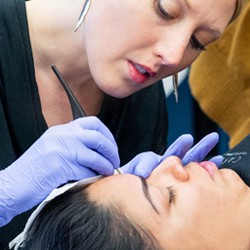Permanent Makeup: Care Instructions for Your Cosmetic Tattoo Procedure
Welcome to Cameo College, where we guide you through your journey of enhancing facial features through permanent makeup. As an educational facility dedicated to beauty and aesthetics, we strive to provide you with comprehensive information about the permanent makeup process and the necessary care instructions to ensure optimal results. Understanding the nuances of this art form, from initial procedures to aftercare, is crucial for anyone considering getting permanent makeup. Our aim is to equip you with the knowledge needed to achieve the desired outcomes while maintaining the health of your skin.
Understanding Permanent Makeup

What is Permanent Cosmetic Makeup?
Permanent cosmetic makeup, often referred to as cosmetic tattooing, involves the application of pigments to the skin to mimic the appearance of traditional makeup. This procedure is designed to enhance facial features such as eyebrows, eyeliner, and lips, providing a long-lasting solution that eliminates the need for daily application of conventional cosmetics. The permanent makeup process involves a detailed application of pigments into the skin, creating a natural look that complements your features. By understanding the intricacies of this art, prospective students can appreciate the skill and precision required in this field.
Benefits of Cosmetic Tattooing
Cosmetic tattooing offers numerous benefits, making it an appealing choice for those looking to simplify their beauty routines. One of the primary advantages is the convenience it provides, eliminating the daily hassle of applying makeup. Additionally, it is particularly beneficial for individuals with allergies to traditional cosmetics or those who have trouble applying makeup due to physical limitations. Permanent makeup also offers peace of mind for those with oily skin, as it is resistant to smudging and fading. With proper care and aftercare instructions, the final results can be both natural and enduring.
Common Procedures Associated with Permanent Makeup
Permanent makeup encompasses several commonly requested procedures, including microblading for eyebrow enhancement, permanent eyeliner, and lip tinting. Microblading involves creating fine, hair-like strokes that mimic the natural brow, perfect for achieving fuller eyebrows. The eyeliner procedure enhances lash lines, giving eyes a more defined look. Each of these cosmetic procedures requires a keen understanding of skin types and the healing process, as well as the importance of proper care post-procedure. By familiarizing yourself with these procedures, you can better understand the artistry and technical expertise needed to excel in this field.
Before Your Permanent Makeup Procedure

Photo by Ott Maidre on Pexels
Preparing for Your Cosmetic Tattoo
Embarking on the journey of permanent makeup requires careful preparation to ensure optimal results. At Cameo College, we emphasize the importance of understanding the intricacies involved in cosmetic tattooing. Prior to your procedure, it is essential to familiarize yourself with the specific steps needed to prepare your skin. Here are some key steps to consider:
- Avoid sun exposure and steer clear of tanning beds, as they can affect pigment retention and the overall appearance of the cosmetic tattoo.
- Refrain from using certain skincare products that contain retinoids or exfoliants to help create a stable canvas for the artist.
By taking these preparatory steps, you enhance your chances of achieving the desired outcome while minimizing potential complications during the healing process.
Consultation and Expectations
A thorough consultation is a vital part of the permanent makeup process at Cameo College. During this stage, prospective clients discuss their beauty goals and expectations with a trained professional. This is the time to address any concerns you may have and to understand the nuances of the procedure, including the healing time and potential for minor redness or scabbing. Discussing your skin type and history of keloid formation is crucial to tailor the procedure to your needs. The consultation also covers aftercare instructions to ensure proper care of the treated area. Understanding these factors helps in setting realistic expectations and prepares you for the journey ahead.
Skin Assessment and Health Considerations
Before proceeding with any cosmetic tattoo procedure, a comprehensive skin assessment is necessary. At Cameo College, we stress the importance of evaluating your skin type and health history to customize the procedure to your unique needs. This assessment helps identify potential issues such as allergies, oily skin, or a tendency to scar, ensuring that the tattoo procedure is safe and effective for you. If you have sensitive skin or a history of allergic reactions, a patch test may be recommended to prevent adverse effects. Understanding your skin’s health is crucial in determining the best approach, ensuring that the cosmetic tattoo heals properly and looks natural.
Aftercare Instructions for Permanent Makeup

Photo by George Milton on Pexels
Initial Healing Phase
The initial healing phase following a permanent makeup procedure is crucial for achieving the desired results. During this period, it is essential to take care of your skin to aid in the healing process. Here are some important aftercare tips to follow:
- Avoid touching or scratching the treated area to prevent disrupting pigment retention and causing scabbing.
- Avoid sun exposure and refrain from using tanning beds to protect the delicate skin from further irritation.
Mild redness and slight swelling are normal, but these symptoms should subside within a few days. Applying a gentle, fragrance-free cream may help soothe the area. Always follow the aftercare instructions provided by your technician to ensure optimal healing and beautiful, long-lasting results.
Long-Term Care for Your Skin
Proper long-term care is essential for maintaining the beauty and longevity of your permanent cosmetic makeup. Regularly applying sunscreen to areas treated with cosmetic tattooing, such as brows and eyeliner, helps prevent fading caused by UV exposure. Incorporating gentle skin care products into your routine will maintain the health of your skin without irritating the tattooed areas. Be mindful of using products containing retinoids or exfoliants that might affect the pigment. Consistent care not only preserves the vibrancy of the pigments but also supports the overall health of your skin, ensuring that your cosmetic tattoo continues to enhance your features beautifully over time.
Dealing with Scarring and Healing Issues
While most individuals experience a smooth healing process, some may encounter issues such as scarring, especially if there is a history of keloid formation. It is crucial to monitor the treated area for signs of complications, such as excessive redness or unusual scarring. If you notice any concerns, consult your technician promptly. Avoid using harsh skin care products or engaging in activities that may irritate the area. For those prone to scarring, a patch test prior to the procedure can help minimize risks. By addressing any healing issues early and following proper aftercare guidelines, you can ensure the best possible outcome for your permanent makeup.
Final Thoughts on Permanent Cosmetic Care
Best Practices for Aftercare

Photo by Kelly Sikkema on Unsplash
After undergoing a permanent cosmetic procedure, adhering to best practices for aftercare is vital to ensure optimal healing and pigment retention. Here are some essential steps to follow:
- Avoid touching or scratching the treated area to prevent infection and scarring.
- Keep the area clean and apply a gentle, fragrance-free cream to soothe redness and expedite healing.
- Avoid sun exposure and refrain from using tanning beds, as UV rays can cause the pigment to fade prematurely.
- Steer clear of products containing harsh chemicals or exfoliants, which can interfere with the healing process.
By following these aftercare instructions, you can achieve the desired final results and maintain the beauty of your permanent makeup.
When to Seek Professional Help
While most individuals experience smooth healing following their permanent makeup procedure, it is essential to know when to seek professional help. If you notice excessive redness, unusual scabbing, or signs of an allergic reaction, consult your technician promptly. These symptoms might indicate that the treated area is not healing properly or that there is a risk of developing complications like keloids. Remember to address concerns about your skin type or history of allergic reactions during your initial consultation to minimize potential issues. Professional guidance ensures that any healing problems are managed effectively, preserving the integrity of your cosmetic tattoo and safeguarding your skin’s health.
Ensuring Longevity of Your Permanent Makeup
To ensure the longevity of your permanent makeup, integrating proper care into your daily routine is essential. Regularly apply sunscreen to protect the delicate pigments in areas like your eyebrows and eyeliner from sun exposure. This prevents premature fading and maintains vibrant colors. Consider scheduling periodic touch-ups to refresh the pigments and enhance facial features over time. Using gentle skin care products that are free from abrasive elements will help maintain the treated area’s health without compromising the cosmetic tattoo. By taking these steps, you can enjoy the benefits of your permanent makeup for years to come, maintaining its appeal and effectiveness.

